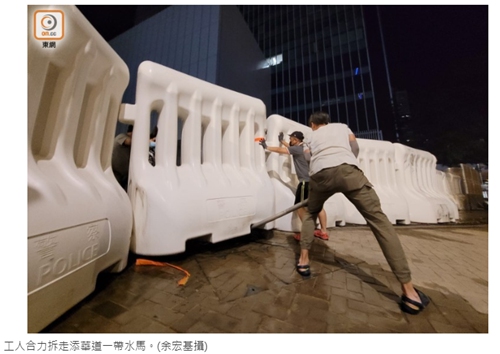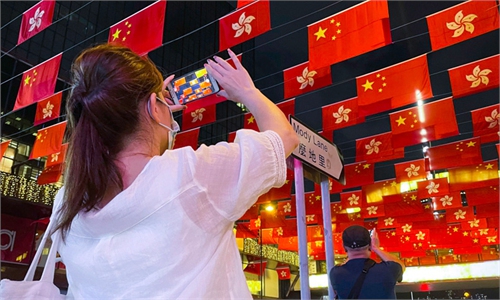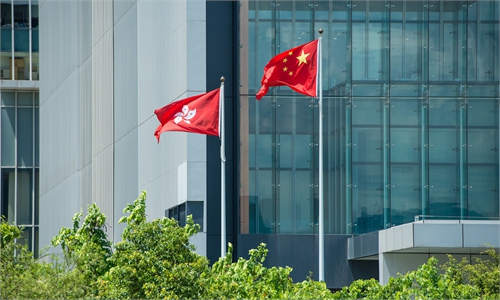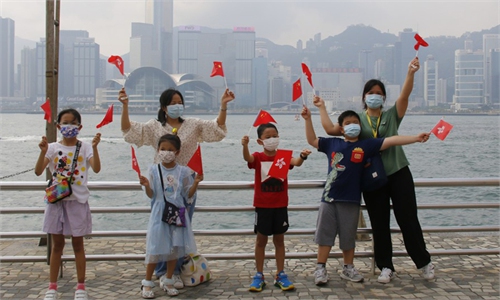Barriers used during black terror removed from HK official buildings, marking return to safety amid National Day celebrations

Workers remove water-filled barriers at Tim Wa Avenue. Photo: screenshot of on.cc
The water-filled barriers set up outside the buildings of Hong Kong Special Administrative Region (SAR) government and the Legislative Council for more than two years were removed on Saturday, marking the city has fully returned to normal and can now focus on economic growth and improving the livelihoods of ordinary citizens in line with national development blueprint, observers said.Besides HKSAR premises, the Liaison Office of the Central People's Government in Hong Kong also saw the two-meter-tall water-filled plastic barriers removed overnight, Hong Kong local news outlets reported.
The barriers were set up in 2019 when rioters raided those buildings and severely impacted social order across the city. The LegCo building was raided on July 1, 2019 while the liaison office building was assaulted on July 21 that year. Many other government department facilities were also attacked during the riots, prompting the erecting of the barriers.
After the implementation of the national security law for Hong Kong on June 30, 2020, violence largely disappeared in the city, and the Wan Chai Police Headquarters became the first to remove the barriers in October 2020.
Commenting on the removal, HKSAR Chief Secretary John Lee Ka-chiu wrote online that the move marked Hong Kong has fully returned to safety.
Hong Kong residents celebrated a joyful National Day with national and SAR flags prominently on show across the city, in a sharp contrast to the National Day holidays in 2019 when black terror and external interference devoured the city. Rioters threw Molotov cocktails, setting fire to shops and buildings, and wantonly destructed subway stations, police offices, government buildings and stores, Lee wrote, according to HKSAR government's website.
Lee introduced that after the black terror was eradicated, the government repaired and beautified the city, where nearly 300 jobs were created for the purpose.
Observers told the Global Times that the major change in the atmosphere throughout the city can be felt by everyone, as safety, peace and stability returned, which is hard to imagine two years ago.
Tian Feilong, an associate professor at Beihang University's law faculty and a member of the Chinese Association of Hong Kong and Macao Studies, told the Global Times that the national security law for Hong Kong deterred potential rioters and the external forces behind them. Government departments can function properly while residents living in peace and safety again.
The improved social atmosphere can also be seen in the disbandment of some opposition groups, including the Professional Teachers' Union and Civil Human Rights Front (CHRF), which were involved in mobilizing and manipulating violent protests and riots, analysts said.
On Sunday, Hong Kong Confederation of Trade Unions (HKCTU), which was founded by anti-government figure Lee Cheuk-yan, passed a motion at a special assembly to disband the group. The HKCTU has been revealed to receive financial support for the past 26 years from overseas, including US-backed foundations, Hong Kong media previously reported.
The consecutive disbandment of anti-government groups serving as agents of external forces demonstrated how the legal progress has protected Hong Kong from foreign interference, analysts said.
Lee stressed that the law has had an immediate effect on eliminating disruptive forces, and external forces can no longer blatantly interfere in Hong Kong affairs. The LegCo can function better under the principle of "patriots governing Hong Kong." Some 40 legal ordinances are expected to be approved at the LegCo, double the annual average of 20 before and HK$280 billion ($36 billion) can be allocated to boost construction, development and employment of Hong Kong.
Lee expressed confidence in HKSAR's future within the framework of the nation's 14th Five-Year Plan (2021-25), the blueprint for the Guangdong-Hong Kong-Macao Greater Bay Area and the Overall Planning for the Development of the Qianhai Shenzhen-Hong Kong Modern Service Industry Cooperation Zone.



